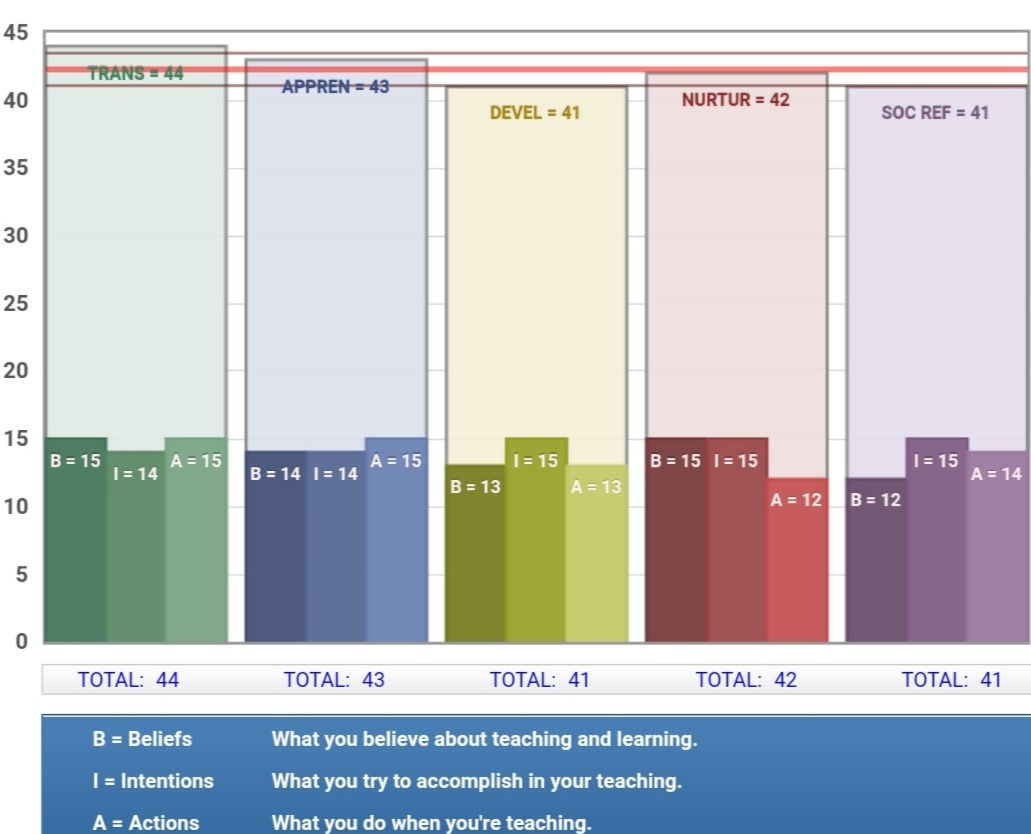Teaching Perspectives Inventory (TPI) helps us to identify the actions, intentions, and beliefs that make our perspective on teaching or in facilitating learning (Pratt & Collins, 1998). While doing and evaluating this inventory, there is a significant need to analyze the conclusion of the inventory to revive and improve our teaching-learning process. Pratt and Collins (2011), suggests some key points to consider while analyzing the conclusion such as- Keeping a note of the height and range of overall scores, Checking the differentiation among the perspectives, Identifying dominant, back-Up, and recessive perspectives, Checking for internal consistency, Examining any internal discrepancies, Looking for consistency across perspectives, Self-Collaboration with peer validation and Reconfirming change.
I don’t doubt the results of my TPI survey. For me, the results were according to my teaching philosophy. My focus as a teacher is always is on completing learning objectives in time and also creating a learning environment through a ‘hands-on approach’. Montessori and Dewey believed in ‘learning by doing’. It creates interest and freedom and makes the child attentive and responsible for nature and society (O’Donnell, 2013). Engaging students in social- eco clubs, events (I days), allowing them to work independently results in effective learning. This philosophy of mine is visible in my TPI results in which I got High scores in the Transmission and Apprenticeship perspectives. Nurture (care) another significant approach that I adapt, this perspective is second in my TPI ratings (the backup perspective). I did this survey based on my past teaching experience, which is very much influenced by the type of curriculum, school environment, values, and society.
The flipped classroom is a better option than the traditional classroom as it brings the best of the traditional and online classrooms. It helps to improve and build new knowledge over prior knowledge, creates interest, attention, and concentration in the learner, and gives the teacher more time with the learner for discussion and feedback. But flipped classrooms work better in higher and university education.
References
O’Donnell, M. (2013). Montessori and the first children’s house. Maria Montessori: A critical introduction to key themes and debates. Retrieved from http://ebookcentral.proquest.com
Pratt, D. D. & Collins, J. B. (1998). Teaching Perspectives Inventory. https://static1.squarespace.com/static/555cfb18e4b039100196660b/t/55949f93e4b0556873d9fa50/1435803539346/Teaching+Perspectives+Inventory-Dan+Pratt.pdf
Pratt, D. & Collins, J. (2011). Summary of five perspectives on ‘Good teaching’. TPI – Teaching Perspectives Summaries. http://blogs.ubc.ca/srikanth/files/2011/12/TPI-Teaching-Perspectives-Summaries.pdf
Teaching Perspectives Inventory. (2020, October 14). TPI profile sheet [Image]. http://www.teachingperspectives.com/tpi/tpisurveyresult.html?surveyid=341797&languageid=1


Hello Gagan
Thank you for sharing your great ideas. I also agree that the results of TPI reflect our different views on teaching.Indeed, our teaching views are deeply influenced by our learning experience, our teaching experience.The results of TPI can help teachers discover their subjective views and invisible views, so that teachers can measure whether these views are consistent with their original role as teachers.Secondly, I also think flipped classroom is a very good new educational concept, which, of course, should be more widely promoted and implemented in this year’s epidemic.This concept has changed the roles of teachers and students in the teaching process.Teachers have changed from the owners and disseminators of knowledge to the guiders of learning methods and processes.Students have changed from passive receivers to active learning subjects who accept knowledge, find problems and try to solve problems.Of course, due to technical problems, I quite agree with you that it does not apply to young students.Only in higher education, when students have more self-control in learning, can they study more effectively after class.
Best,
Sheng Li
Hello Gagandeep,
Thanks for such a wonderful explanation about your TPI results. TPI definitely helps us to improve ourselves, especially in the teaching profession. I agree with you that as being an educator, it is our responsibility to complete learning objective in time. Moreover, the flipped classroom provides a great opportunity for students to learn by using technological devices and helps them to enhance their technological skills. It works better in higher and university students who are mature enough to take advantage of the flipped classrooms at their own pace that is however not possible for primary and secondary school students.
Regards